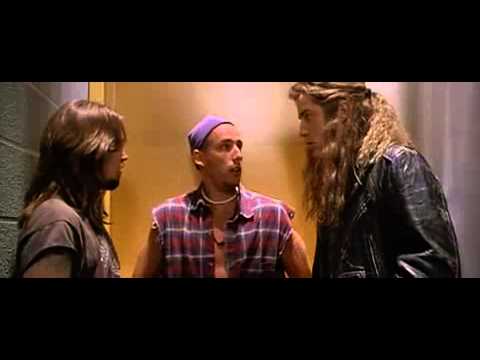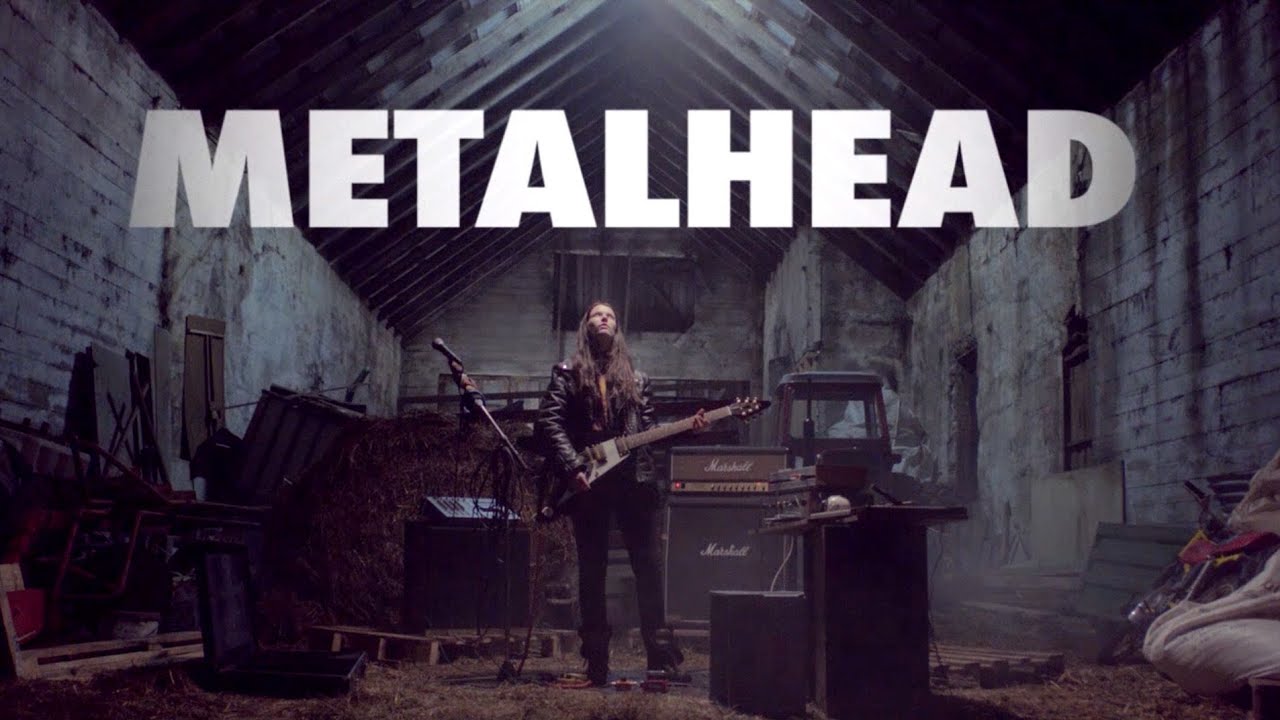Over the years, heavy metal has established itself as a stubbornly enduring facet of popular culture. So it only makes sense that filmmakers would attempt to depict this music and its fans. Unfortunately, many of these depictions simply reinforce the stereotype of metal heads as mouth-breathing jerks.
Airheads (1994) tells the story of three brainless metal musicians who break into a radio station in order to get their music played. The Bash Brothers, two metal-loving hockey players in D2: The Mighty Ducks, (1994) are essentially cavemen, routinely head-butting each other to show affection. For characters in Selena (1997) and Don’t Tell Mom The Babysitter’s Dead, (1991) being a metal head is an adolescent phase that gives them an excuse to act like jackasses. Zakk Wylde of Black Label Society plays Ghode in Rockstar, (2001) another loudmouthed metal head caricature that has the depth of a kiddie pool.
Metal culture definitely has its problems. In the worst cases, it can be a small-minded and intolerant boys club. There’s certainly a lot of dumbasses in the metal world, but there’s just as many smart, kindhearted people that love this music because it directly looks at the harshest aspects of life. These thoughtful people are the true metal heads, and there are a few films that capture the pulse of this identity, such as Ragnar Bragason’s Metalhead, which came out in 2013. At one point in the movie, someone asks Hera, the headbanging protagonist, why she listens to such negative music. Hera’s response: “Because it doesn’t sugarcoat anything.”
At its roots, heavy metal is a proletarian music that examines the ugliest aspects of humanity. Whereas pop often promotes a more optimistic worldview, metal has historically been by and for those of us who see the glass as half empty. Black Sabbath laid the foundation for this genre with Black Sabbath and Paranoid, albums that revolve around anger, self-destruction, and deep-seated pessimism. Hera is also defined by these characteristics, making her an archetypical metal fan. And through Hera, Ragnar Bragason illustrates a nuanced understanding for the genre and the people it attracts.
Hera and her family live on a small cattle farm in an Icelandic village. At a young age, she discovers the gruesome remains of her older brother, Baldur, who’s gotten scalped and gutted in a farming accident. Baldur’s brutal death leaves an indelible mark on Hera and her parents, and the majority of Metalhead shows a family who, roughly ten years later, are still spinning from this tragedy.
Baldur was a metal head, and Hera adopts this identity as a way to stay connected to him. Immediately after the funeral, Hera burns her clothes, exchanging her pink-and-turquoise wardrobe for Baldur’s Iron Maiden and Motörhead t-shirts. She also starts playing guitar, using her brother’s jet-black Les Paul. Metalhead then moves forward a decade or so, during which time Hera has taken her headbanger persona to an extreme.
Hera’s progression as a character is directly connected to her ability to transform her anger into something productive—a process that, in many ways, is the lifeblood of heavy metal. Roughly halfway through Metalhead, Hera records a relentlessly cold black metal demo, using her barn as a studio. Shortly afterward, she gives her rage a more destructive outlet. Inspired by the slew of black metal-related church burnings that took place in Norway throughout the ’90s, she burns a church to the ground.
One of defining challenges of being a metal head is to focus on the most negative aspects of life while still retaining the ability to construct meaning. Without some way to express their anger, many metal heads destroy themselves and their surroundings. The crux of Hera’s conflict is whether she can channel her fury in a positive way or if her rage will eat her alive, which makes her a metal head in the truest sense. Because she’s a woman, Hera also challenges stereotypical notions about who heavy metal is for. Although the genre is overrun with misogynistic assholes, it’s music for anyone who feels alienated by mainstream society.
Another brilliant aspect of Metalhead is how its soundtrack doesn’t overuse metal. Of course the film features classic metal songs like Judas Priest’s ‘Victims Of Change,’ Megadeth’s ‘Symphony Of Destruction,’ and Diamondhead’s ‘Am I Evil.’ But the soundtrack largely consists of sparse classical – sounds that emphasise the desolation of Hera’s ever-burning anger and her unforgiving natural surroundings.
Like the way metal heads are typically portrayed, filmmakers often depict heavy music as being empty and moronic. Perhaps the most well known example is Rob Reiner’s 1984 mockumentary, Spinal Tap. Reiner’s film follows David St. Hubbins, Derek Smalls, and Nigel Tufnel – three metal musician stereotypes in the flesh. Their band, Spinal Tap, is on tour to promote a new album, and their music is hilariously bad. With songs like ‘Sex Farm,’ ‘Hell Hole,’ and ‘Tonight I’m Gonna Rock You Tonight,’ Reiner’s fictional band deservingly satirises the tropes of mainstream metal. But, while there will likely always be metal bands that don’t have much going for them aside from empty shock value and sex appeal, heavy metal can also be profound.
By creating masterful pieces of music that focus on intensely negative themes, metal bands accomplish that essential human act of constructing art out of suffering. A few heavy albums out of the thousands that are obsessed with violence, death, mental illness, and social injustice: Metallica’s Master of Puppets, Napalm Death’s Scum, Neurosis’s Through Silver In Blood, and Eyehategod’s Dopesick. Each of these albums is challenging in its own way, requiring the listener to find meaning in harshness. In Spencer Susser’s 2010 film, Hesher, Joseph-Gordon Levitt’s metal head character teaches a grief-stricken family about this transformative process via the gospel of heavy fucking music.
Hesher tells the story of a young teenager, T.J., who’s mom recently died in a car accident. T.J., his dad, Paul, and grandma, Madeleine, are reeling from the loss, but Madeleine is the only one who’s made any progress in coping. Consumed by depression, Paul can barely get off the couch. There’s a whirlpool of anger and sadness spinning within T.J., but he doesn’t know how to handle it. He also gets bullied at school, which doesn’t help anything.
Enter Hesher, who, with his scraggly hair and greasy clothes, looks like a roadie for Pantera.
Hesher is a classic antihero. However, with a tattoo of an extended middle finger on his back, he initially seems like little more than an asshole. Shortly after moving into T.J.’s garage, Hesher takes him on a drive, blasting Metallica’s ‘Battery’ and not answering the kid’s questions about where they’re going. To T.J.’s horror, Hesher takes him to his bully’s house. The bully proudly drives a yellow convertible, so Hesher lights the car on fire. He then gets in his windowless van and drives away, leaving T.J. to flee on his own. When they meet again, T.J. kicks Hesher in the balls, hard. Instead of beating T.J.’s ass, though, Hesher just laughs, marking the first time in the movie when he’s actually pleased with the kid.
Throughout Hesher, T.J. learns to stand up for himself, express his anger, and live his life – all things that he absorbs from his metal head friend. Hesher often acts like a dick, but his effect upon T.J., as well as Paul and Madeleine, is undeniably positive. Talking with T.J.’s grandma one night, Hesher communicates the lesson he wants to pass on to the family by telling a story about his pet snake. He fed the snake mice for a few years until one mouse refused to get eaten. When the snake tried to kill it, the mouse punched the reptile in the face. Hesher dropped more mice into the cage, but the snake just cowered in a corner and eventually starved to death as vermin overtook its home. T.J., Paul, and Madeleine can either get eaten by pain, or they can punch that snake in the face by moving on and trying to find happiness, even if that only happens by living more fully in each moment. This is also one of the central themes coursing through the veins of heavy music.
Instead of functioning as exploitative crutches for the movie, the metal songs in Hesher reinforce this thematic core. ‘Battery,’ the infamous opening track on Master Of Puppets, and one of Hesher’s favorite songs, features lyrics about a seething internal violence. James Hetfield yells, “Battery is found in me,” amid the manically thrashing chorus, but the song begins with delicate acoustic that builds into a wall of simultaneously crushing and beautiful duel harmony guitars. In essence, ‘Battery’ and Hesher communicate the same message: life is often intensely negative. In order to keep going we have to construct meaning out of this negativity.
Hesher and Metalhead both illustrate that there’s a lot more depth to heavy metal and its fans than more stereotypical representations would have us believe. Although the genre is often ridiculous, this music can also be deeply substantial. In addition to making you understand metal heads and music in completely new ways, these movies will also make you want to viciously headbang to some early Metallica. Just make sure to exercise caution if you do so in your car.




